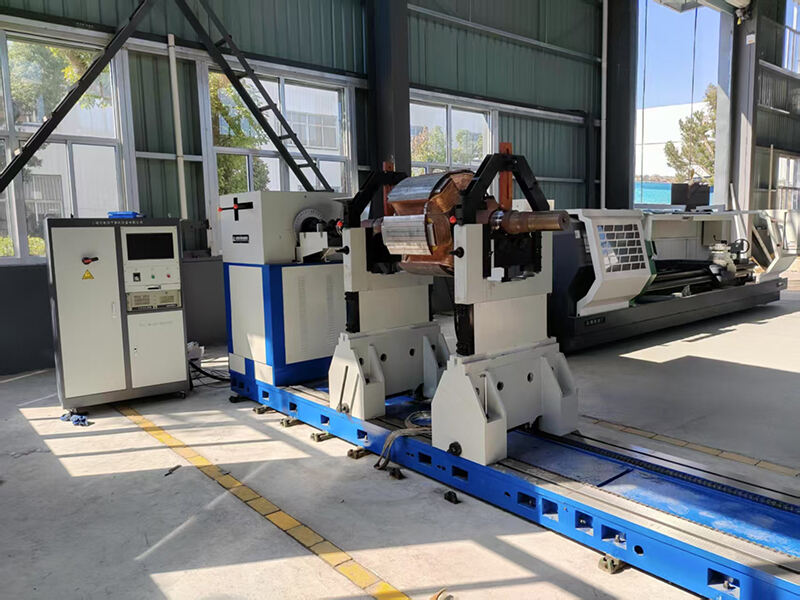Industrial organizations compete in a challenging market by implementing state-of-the-art methods that promote operating effectiveness, reducing resource loss and general production improvement. Dynamic balanced machines serve as the required tools to meet such performance objectives. Research examines methods that optimize industrial production by explaining their operational mechanisms and their various applications in dynamic manufacturing settings.

The basic operation of dynamic balanced machines requires clarification.
Rotating components, including shaft wheels with other machinery parts, require dynamic balance as an operational process to prevent dangerous vibration. Dynamic balances employ maintenance processes that adjust the rotation object mass positions until the center of mass is absolutely on the rotation axis.
A rotating component creates centrifugal forces during unbalanced conditions, resulting in unbearable vibrations with audible noise and destructive oscillations. Such effects reduce the performance of the machine and shorten equipment lifespan, resulting in duration blockage and high maintenance costs.
Detection of imbalance acts as the main capacity of dynamic balance machines. The tool rotates the component while the sensors measure the vibrations made. The tool uses measures captured to determine the state of imbalance along with intensity. After assessing the unbalanced position, the next process requires either the material removal or adjusting it that restore the balance within the component.
The sequence starts with the following actions to accomplish the balancing objective:
Mounting the Component: During the mounting operation the machine receives the balancing item through its secure mounting system.
Initial Spinning and Measurement: At the start of the process the machine makes the component spin to measure its present vibration levels.
Calculation of Imbalance: Sensors together with software system analyze the data points to establish both the amount and position of imbalance.
Correction: The correction method for balancing depends on imbalance severity because technicians adjust the mass distribution by adding materials and performing adjustments.
Verification: Another spin of the component checks correction success and verifies low remaining unbalance.
The understanding of these functions shows how important it is to rely on dynamic balance techniques to maximize industrial equipment performance.
Major application in modern manufacturing processes
Many industries benefit from dynamic balance machines to enhance their manufacturing processes, through which they get better operating efficiency and product quality enhancement. These are some of the main areas and their respective uses of Dynamic Balancing application:
1. Automotive industry
Dynamic balanced machines guarantee automotive components such as tires and crankshafts and camshafts and brake drums operating excellence for the motor vehicle sector. The imbalance displayed parts inspire wearing and noise that reduces fuel performance. The implementation of dynamic balance systems during manufacturing produces vehicles with better performance stability and safety that improves the customer happiness when cutting the warranty related expenses.
2. Aerospace industry
The aerospace area depends on excessive precision and reliability standards for every stage of its operation. Manufacturers need to maintain strict balance standards for the components of the aircraft including turbine fans and propellers to guarantee both operational excellence and safety. Aerospace corporate institutions maintain their product quality standards through Dynamic Balancing Machine Operations, while important systems do not fails and prolong the operational life of stressed components.
3. Power Generation
Power generation facilities need their turbine and generator systems to work under heavy loads as they minimize vibrations which enhance productivity and avoid machine breakdowns. Dynamic balancing machines help aerospace companies achieve specific component adjustments for smooth power output generation and minimize equipment failures which could lead to operational stoppages. The stable energy supply becomes more efficient due to these measures.
4. Industrial Machinery
Products in the general industrial machinery category benefit from dynamic balancing methods that work for pumps motors blowers and compressors. Rotating equipment in these machines must stay balanced because this practice reduces equipment deterioration while decreasing maintenance spending and boosting service periods. The decrease in mechanical vibrations produces quieter operation suitable for areas that need sound reduction measures.
5. HVAC Systems
HVAC systems need heating ventilation air conditioning devices to use air moving systems such as fans and blowers for flow maintenance. Systems which harmonize all their elements operate with better performance while generating sound reduction and sustaining longer equipment life. Dynamic balancing machines within the manufacturing process enable HVAC manufacturers to produce superior-quality products which achieve dependable long-term performance.
6. Renewable Energy
Wind turbine blades and hydroelectric generator rotors need dynamic balancing for the proper functioning of these components across wind and hydro energy sectors. The successful balancing operation of these significant fast-rotating components enables optimal power conversion from mechanical energy while minimizing vibrations that would cause losses.
Dynamic balancing machines have become essential components for modern manufacturing operations in all their various production domains. Dynamic balancing machines strengthen system performance while boosting component safety and extending the operational duration of essential industrial parts to maximize industrial productivity. Industrial players who master the essential features of dynamic balancing machines can strategically deploy these machines throughout their operations for considerable improvement in productivity and economic gains.




